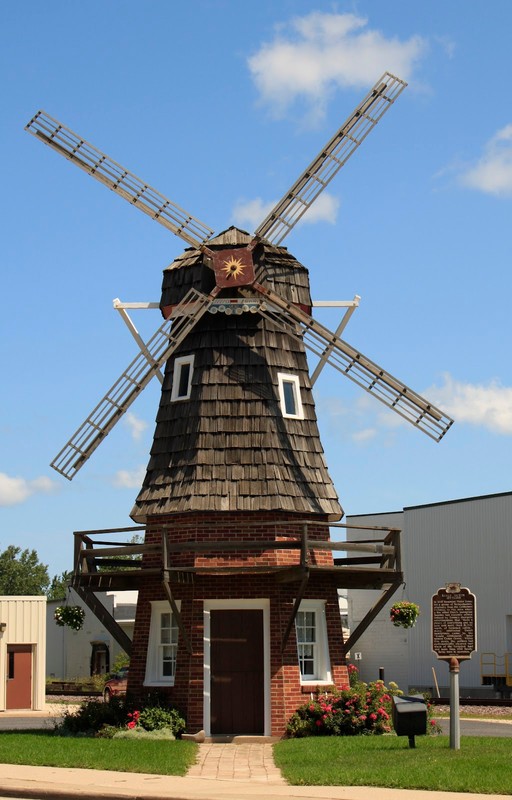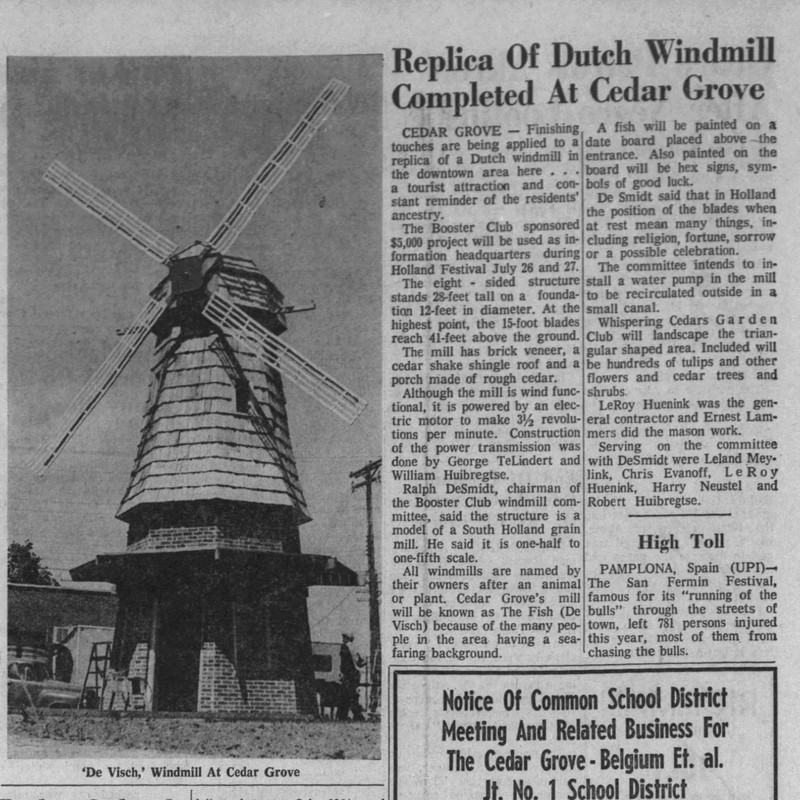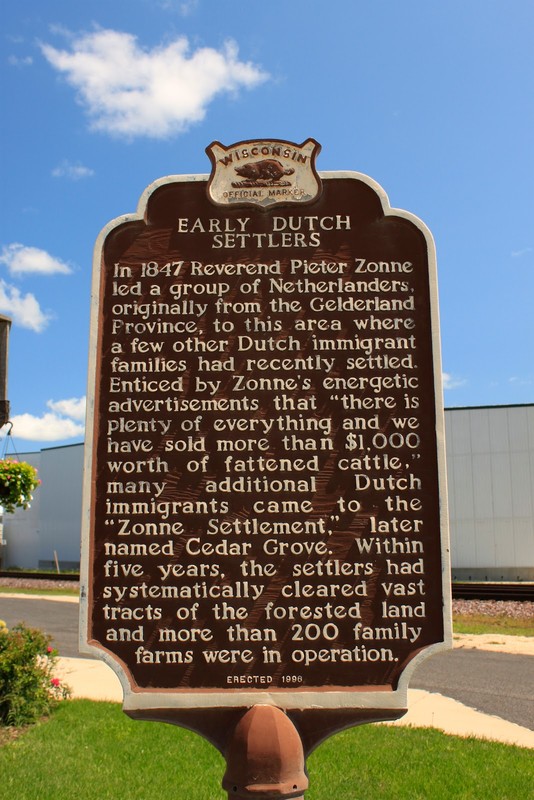Cedar Grove Windmill
Introduction
Text-to-speech Audio
Celebrating the Dutch heritage of Cedar Grove, the "De Visch" windmill was erected in 1968. It is a scale model of the windmills found in Dutch cities and its height allows its blades to catch wind even when surrounded by other buildings. In addition to generating power, the windmill blades would traditionally be used to communicate messages, such as the death of a family member or an engagement.
Images
Cedar Grove Windmill

Replica of Dutch Windmill Completed at Cedar Grove


Backstory and Context
Text-to-speech Audio
Sponsored by the Cedar Grove Booster Club, the Cedar Grove windmill was built in 1968. Construction of the windmill finished in July, just before the annual Holland Festival was scheduled to take place. Designed to serve as a tourist attraction and an education tool to teach residents about their Dutch heritage, the windmill stands 28 feet tall and 12 feet wide at its base. Each blade is 15 feet long, making the total height from the ground to the tip 41 feet.
The windmill is a scale model of a “Stellingmolen” or “Tower Mill,” which are commonly found in Dutch cities. The tall design and long blades allow the mills to still catch wind even when surrounded by other buildings. While the mill is functional with the use of wind, it also uses a motor to power the blades, which turns them at 3.5 revolutions per minute. At the time of its completion, there were plans to add a canal to the grounds that would be circulated by a water pump powered by the mill. There were also great landscaping plans. Originally, the mill was to be surrounded by cedar trees and hundreds of tulips, a popular Dutch flower.
The mill is named “De Visch,” which translates to “The Fish.” Windmills are traditionally named by their owners after an animal or plant. Cedar Grove chose “De Visch” to reflect the life of early settlers from the Province of Zeeland who worked as fishermen at nearby Amsterdam Beach in the Town of Holland. A fish is painted above the entrance and hex signs painted on the boards symbolize good luck.
Did you know that the position of the blades or sails on a windmill could convey messages? When the blades are at rest and left in specific positions they could be a distress signal, announcing a death in a family, or a joyous celebration such as a wedding. In fact, during World War II, Holland used the sails of windmills as secret signals to warn the locals of Nazi raids.
As with most immigrants, there was a combination of factors pushing Dutch immigrants from their old home and into to their new home. The Netherlands was experiencing overcrowding and scarcity of available land. By the 1840s, the Dutch economy was struggling after the industrial revolution failed to take hold in Holland as it had in other European countries. As a result, taxes were extremely high and food was hard to come by due to a devastating potato famine. The country was in turmoil and also faced religious unrest after a newly adopted doctrine within the church proved to be too liberal for many Reformed Dutch Protestants. Immigrants soon left for America hoping to start a new life and find religious freedom.
A large number of these immigrants made their way to Wisconsin, settling in Sheboygan County. Early settlers were able to buy farmland at a very inexpensive price and there was plenty of land to be had. Suitable farmland was selling for $8-12 per acre and timbered land sold for $1.25 an acre!
The first settlers from the Netherlands arrived in 1845 and 1846. Jan Zeeveld and his father Lawrence are documented as the first Dutch settlers to arrive in the county in 1845, followed by Jacob Smidt and Teunis DeVos in late 1845 and early 1846. The Village of Cedar Grove was founded in 1847 after Gerrit Kolste purchased the land from the U.S. Government. The Reverend Pieter Zonne led a group to the area and it is said that he named the village when he observed a grove of cedar trees from the doorway of a cabin belonging to Sweezy Burr.
On November 21, 1847 a group of new Dutch immigrants were 5 miles off Sheboygan’s shore after leaving Manitowoc on the ship, The Phoenix. Around 4am a fire broke out on board. Crew and passengers battled the flames, but to no avail. Sadly, the ship was ill equipped for an emergency and only had two lifeboats. The lifeboats carried 43 people to safety and attempted to go back to rescue more but unfortunately only an additional 3 people survived the icy cold waters of Lake Michigan. The remaining passengers and crew perished in the blaze. Of the 200 men, women, and children on board 175 were Dutch immigrants coming to start their new lives, but only 25 were counted among the survivors.
The Village of Oostburg was founded at about the same time as Cedar Grove but not where it stands today. East Oostburg was the original site, which is some distance east of the present village. The move to the present site was precipitated by the arrival of the railroad where Oostburg now stands. In 1872, the Milwaukee, Lake Shore & Western Railroad reached Cedar Grove, giving the village a massive economic boost.
Other Dutch communities developed included Amsterdam (1852), Gibbsville (1846), and Hingham (1850). Amsterdam, although a separate city from Cedar Grove, had a significant impact on the community. Founded as a fishing village by someone who was not a dutchman, but a Yankee named Gilbert H. Smith, it provided work to many Dutch living in Cedar Grove and surrounding areas. Many Dutch immigrants also lived there and they are believed to be responsible for naming the town. The town was thriving until the railroad came to Cedar Grove. A decline had already begun, but the arrival of the railroad truly brought the demise. By 1904, 91 of the original 131 plots were listed vacant. By 1916, the fishing village of Amsterdam had completely disappeared, vanishing from all maps. The last fishing business still holding on, closed its doors in the 1940s and 20 years later, the surrounding villages decided to convert the deserted shore into Amsterdam Park. In 2014, Sheboygan County partnered with the Glacial Lakes Conservancy to purchase the 328 acre property, creating the Amsterdam Dunes Preservation Area, which is open to the public.
Sources
Travel Back in Time to Cedar Grove, Recollection Wisconsin. Accessed October 5th, 2023. https://recollectionwisconsin.org/travel-back-in-time/cedar-grove.
De Visch Windmill Park, Wisconsin Historical Society. Accessed October 5th, 2023. https://www.wisconsinhistory.org/Records/Image/IM121457.
The Sheboygan Press
